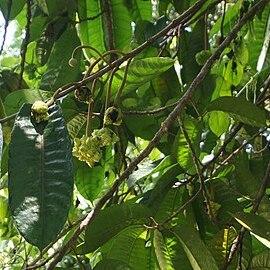Tree up to 30 m tall, sometimes with buttresses. Leafy twigs 2-5 mm thick, sparsely and minutely puberulous. Leaves distichous; lamina subobovate to elliptic, (4-)10-30(-40) by (2.5-)4-13 cm, often ± asymmetric, at least at the base, coriaceous, apex acuminate, base cuneate to rounded to subcordate (at one side) or to subauriculate, margin entire, often ± revolute (towards the base); upper surface glabrous, or puberulous on the veins; lower surface sparsely appressedly puberulous on the main veins to glabrous, scabridulous or smooth; midrib slightly prominent above, lateral veins (8-)12-20(-25) pairs, tertiary venation scalariform; petiole (0.3-)0.8-2(-3.5) cm long, sparsely puberulous to subglabrous, the epidermis often flaking off; stipules c. 0.2 cm long, puberulous or glabrous, caducous. Staminate inflorescences axillary, solitary, capitate; peduncle 1.5-4(-6) cm long, minutely puberulous (or glabrous); head globose, (0.3-)0.5-1.5(-1.8) cm diam.; perianth c. 1.5 mm long, densely minutely puberulous at the apex; stamen c. 1.8 mm long, anther c. 0.4 mm long; bracts peltate, 1.5-2 mm long, the apical part 0.2-0.3 mm diam., whitish to brownish minutely puberulous. Pistillate inflorescences axillary, solitary, capitate; peduncle 1-20(-25) cm long, minutely puberulous; head globose, 0.8-2.5 cm diam.; flowers numerous; perianth 3-4 mm long, densely to sparsely minutely puberulous at the apex; stigmas tongue-shaped, bifid or simple, 0.3-1 mm long; bracts (sub)peltate, 2.5-3 mm long, the upper part 0.3-0.4 mm diam., whitish to brownish minutely puberulous. Infructescences subglobose, 1.5-5 cm diam., with numerous protruding fruiting perianths, these ellipsoid to ovoid, (0.8-)1.2-2.5 cm long, (sub)glabrous, yellowish to reddish at maturity.
More
A tree. It grows about 30 m tall. The stem has white sap. The leaves are alternate and simple. They can be hairy underneath. The flowers are 0.5 mm across and greenish. The flowers are fused into a round flower head. The fruit are 5 cm across and green. They are irregular shaped. Only apart of the fruit is developed.

